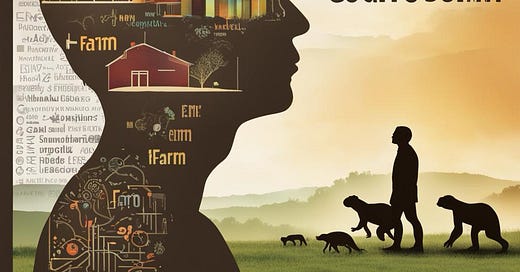Living life physically in the body of a human animal hasn’t radically changed over roughly the past 10,000 or so years. Humans have the same basic parts today though adapted and improved around survival issues—heads, torsos, arms, legs—but body parts evolve subtly, routinely in a three-way interaction among biology, culture, and consciousness. Look at the hands of a jazz pianist, an incredible pair of manipulators galaxies from the paws of a tree-dwelling primate.
“The evolution of our brain and our anatomy advanced in lockstep. The balance between hand bones, tendons, muscles and nerves was constantly being refined, as were the hand’s increasingly sensitive sense of touch and the brain’s ever-more sophisticated oversight of motor coordination.” (Florian Breier, 2020)
Much earlier, big human bones adapted significantly in length and in strength as our primate ancestors began to walk upright in the wild, a survival adaptation, but 200,000 years ago after our brain took charge the game changed, and the body had to catch up. In fact, paleo anthropologists believe that Homo habilis evolved a brain wired for language in a head with a flat clumsy tongue in a short thick throat with a long awkward jaw. Habilis could think but not speak.
Human culture afforded by language became a dominant evolutionary force in combination with geography and climate. Transition from a hunter-gatherer to a more sedentary lifestyle, for example, the result of growing bigger brains, lessened demands for brute strength, thereby diminishing the density and size of bones.
Humans learned to live as farmers and herders, and they learned to cook. Chewing softer foods century after century led to smaller teeth and a reduction in jaw size. To accommodate a new foodstuff made available through animal domestication, some human populations experienced changes in digestion; lactose, a sugar found in milk, needed a special enzyme to become a functional part of our daily bread. Availability of food has affected average height, which has fluctuated as cycles of feast or famine have come and gone.
Rene Descartes in the 17th century has been nominated by some afficianodos to be the first modern philosopher. This distinction grew from the staying power of a five-word phrase that seems to pinpoint both the curse and blessing of humanity: I think; therefore, I am. Great debates rivaling the phonics debate have arisen among deep thinkers over the past few centuries: What does this mean? I think? I am? Speaking anthropologically, simply by changing the tense to the future perfect indicative—I think; therefore, I will be—we discern a sweeter story than the bitter taste of the past perfect conditional—I thought not deeply enough; therefore, I could have been.
In the folds of this paradigm exist at least five big ideas that might serve as a heuristic for unit and lesson design: consciousness, cognition, emotion, agency, and action. Consciousness, of course, is scientifically a matter of degree. A century ago Vygotsky used observations of chimpanzees using sticks as tools to imagine language as a metaphorical tool of consciousness. Elephants, dolphins, whales, pigs—all exhibit high degrees of consciousness.
Thomas Nagel’s famous essay “What Is It Like to Be a Bat?” (1974) argued quite convincingly that consciousness is inherently subjective. I have mine, you have yours, and the theoretical problem of intersubjectivity remains intractable. Practically, teachers might start from the premise that every student has a right to an individual consciousness that others have no right to override—indeed, demanding as an other full control of consciousness as the time-on-task literature suggests is counterproductive.
Cognition is a second significant pedagogical consideration, the “think” in Descartes’ claim in history. "Thinking is the hardest work there is, which is probably the reason so few engage in it,” Henry Ford is said to have said. All cynicism aside, Ford had a point. Thinking is hard. Where teachers are concerned, the trick to making an activity as hard as thinking is tapping into motive, intention. Motive is clearly transitive, working its way from consciousness to cognition through relevance. Teachers can’t force a learner to see relevance in a curriculum topic, but by respecting each individual’s consciousness, they can guide the path and strike a spark of thought.
Emotion follows suit. Once a learner begins to care about the content of thinking, once motive becomes emotion, teachers face the fascinating challenge of influencing patterns of learning. The way they test students, what they say to and about them, the structures and tools they provide or allow including management of the curriculum, the modeling they exhibit, the social spaces they make available, the language they use to talk about language and thinking—in many ways, an educator’s impact on motivation may have the most lasting effect on durable dispositions of consciousness.
Agency, being a legitimate participant in logical and imaginative thought, being a writer and a reader, doing science and math, living in and watching history—agency cannot be wheeled into a classroom on a cart nor baked like a cake recipe. It can be offered and nurtured, reflected upon and discussed, respected and enacted. The final step, action, takes the fruits of cognition, motivation, and agency and returns them to feed consciousness as the source of next steps. What do we do next? Where do we turn? What will I be? What could I become?
What now?
The syntactic space reserved for a learner’s transitive imagination in the future tenses, will be, could be, might become, open the aperture on a glimpse of a pedagogical paradigm in which teachers might think long-long range about lesson planning. Working in learning outcomes assessment in higher education for many years, I subscribed to sentiments like “A learning outcome is what’s left after everything else has been forgotten.” We might amend the sentiment: “A learning outcome is what shows up long after we are dead and gone.”
***
CCEAA
Consciousness
Cognition
Emotion
Agency
Action




You are an amazingly inventive guy, Terry!!!!